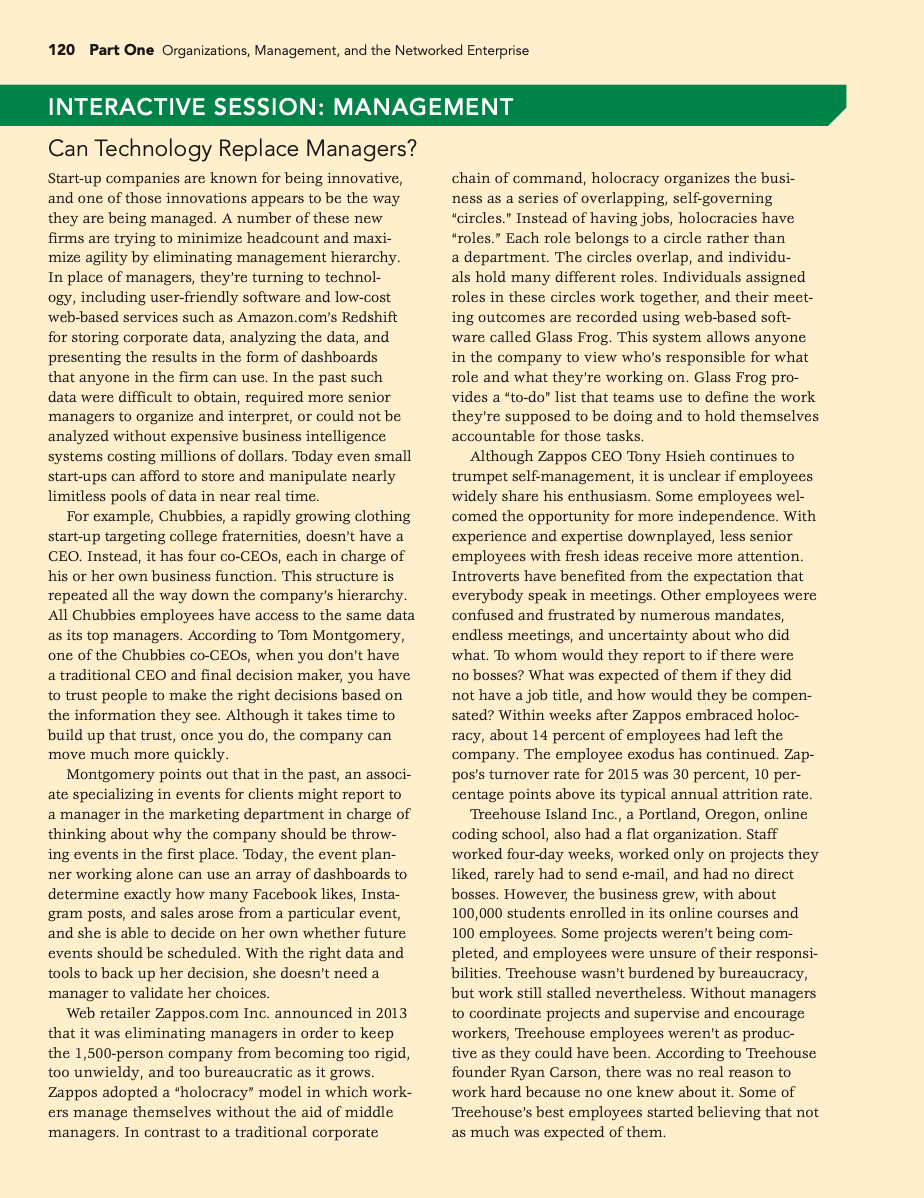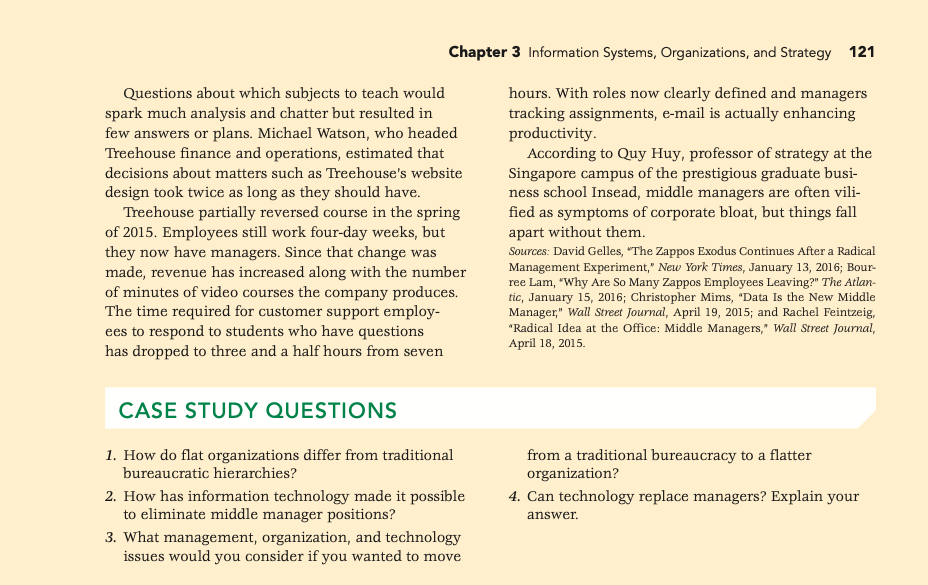How do flat organizations differ from traditional bureaucratic hierarchies? How has information technology made it possible to eliminate middle manager positions? What management, organization, and technology issues would you consider if you wanted to move from a traditional bureaucracy to a flatter organization? Can technology replace managers? Explain your answer.
How do flat organizations differ from traditional bureaucratic hierarchies? How has information technology made it possible to eliminate middle manager positions? What management, organization, and technology issues would you consider if you wanted to move from a traditional bureaucracy to a flatter organization? Can technology replace managers? Explain your answer.
Chapter1: Taking Risks And Making Profits Within The Dynamic Business Environment
Section: Chapter Questions
Problem 1CE
Related questions
Question
- How do flat organizations differ from traditional bureaucratic hierarchies?
- How has information technology made it possible to eliminate middle manager positions?
- What management, organization, and technology issues would you consider if you wanted to move from a traditional bureaucracy to a flatter organization?
- Can technology replace managers? Explain your answer.

Transcribed Image Text:120 Part One Organizations, Management, and the Networked Enterprise
INTERACTIVE SESSION: MANAGEMENT
Can Technology Replace Managers?
Start-up companies are known for being innovative,
and one of those innovations appears to be the way
they are being managed. A number of these new
firms are trying to minimize headcount and maxi-
mize agility by eliminating management hierarchy.
In place of managers, they're turning to technol-
ogy, including user-friendly software and low-cost
chain of command, holocracy organizes the busi-
ness as a series of overlapping, self-governing
"circles." Instead of having jobs, holocracies have
"roles." Each role belongs to a circle rather than
a department. The circles overlap, and individu-
hold many different roles. Individuals assigned
roles in these circles work together, and their meet-
ing outcomes are recorded using web-based soft-
ware called Glass Frog. This system allows anyone
web-based services such as Amazon.com's Redshift
for storing corporate data, analyzing the data, and
presenting the results in the form of dashboards
that anyone in the firm can use. In the past such
data were difficult to obtain, required more senior
managers to organize and interpret, or could not be
analyzed without expensive business intelligence
systems costing millions of dollars. Today even small
start-ups can afford to store and manipulate nearly
limitless pools of data in near real time.
For example, Chubbies, a rapidly growing clothing
start-up targeting college fraternities, doesn't have a
CEO. Instead, it has four co-CEO,, each in charge of
in the company to view who's responsible for what
role and what they're working on. Glass Frog pro-
vides a "to-do" list that teams use to define the work
they're supposed to be doing and to hold themselves
accountable for those tasks.
Although Zappos CEO Tony Hsieh continues to
trumpet self-management, it is unclear if employees
widely share his enthusiasm. Some employees wel-
comed the opportunity for more independence. With
experience and expertise downplayed, less senior
employees with fresh ideas receive more attention.
Introverts have benefited from the expectation that
everybody speak in meetings. Other employees were
confused and frustrated by numerous mandates,
endless meetings, and uncertainty about who did
what. To whom would they report to if there were
no bosses? What was expected of them if they did
not have a job title, and how would they be compen-
sated? Within weeks after Zappos embraced holoc-
racy, about 14 percent of employees had left the
company. The employee exodus has continued. Zap-
pos's turnover rate for 2015 was 30 percent, 10 per-
centage points above its typical annual attrition rate.
Treehouse Island Inc., a Portland, Oregon, online
coding school, also had a flat organization. Staff
worked four-day weeks, worked only on projects they
rarely had to send e-mail, and had no direct
bosses. However, the business grew, with about
100,000 students enrolled in its online courses and
100 employees. Some projects weren't being com-
pleted, and employees were unsure of their responsi-
bilities. Treehouse wasn't burdened by bureaucracy,
but work still stalled nevertheless. Without managers
to coordinate projects and supervise and encourage
workers, Treehouse employees weren't as produc-
tive as they could have been. According to Treehouse
founder Ryan Carson, there was no real reason to
his or her own business function. This structure is
repeated all the way down the company's hierarchy.
All Chubbies employees have access to the same data
as its top managers. According to Tom Montgomery,
one of the Chubbies co-CEOS, when you don't have
a traditional CEO and final decision maker, you have
to trust people to make the right decisions based on
the information they see. Although it takes time to
build up that trust, once you do, the company can
move much more quickly.
Montgomery points out that in the past, an associ-
ate specializing in events for clients might report to
a manager in the marketing department in charge of
thinking about why the company should be throw-
ing events in the first place. Today, the event plan-
ner working alone can use an array of dashboards to
determine exactly how many Facebook likes, Insta-
gram posts, and sales arose from a particular event,
like
and she is able to decide on her own whether future
events should be scheduled. With the right data and
tools to back up her decision, she doesn't need a
manager to validate her choices.
Web retailer Zappos.com Inc. announced in 2013
that it was eliminating managers in order to keep
the 1,500-person company from becoming too rigid,
too unwieldy, and too bureaucratic as it grows.
Zappos adopted a "holocracy" model in which work-
ers manage themselves without the aid of middle
managers. In contrast to a traditional corporate
work hard because no one knew about it. Some of
Treehouse's best employees started believing that not
as much was expected of them.

Transcribed Image Text:Chapter 3 Information Systems, Organizations, and Strategy 121
Questions about which subjects to teach would
spark much analysis and chatter but resulted in
few answers or plans. Michael Watson, who headed
Treehouse finance and operations, estimated that
hours. With roles now clearly defined and managers
tracking assignments, e-mail is actually enhancing
productivity.
According to Quy Huy, professor of strategy at the
Singapore campus of the prestigious graduate busi-
ness school Insead, middle managers are often vili-
fied as symptoms of corporate bloat, but things fall
apart without them.
decisions about matters such as Treehouse's website
design took twice as long as they should have.
Treehouse partially reversed course in the spring
of 2015. Employees still work four-day weeks, but
they now have managers. Since that change was
made, revenue has increased along with the number
of minutes of video courses the company produces.
The time required for customer support employ-
ees to respond to students who have questions
has dropped to three and a half hours from seven
Sources: David Gelles, "The Zappos Exodus Continues After a Radical
Management Experiment," New York Times, January 13, 2016; Bour-
ree Lam, "Why Are So Many Zappos Employees Leaving?" The Atlan-
tic, January 15, 2016; Christopher Mims, "Data Is the New Middle
Manager," Wall Street Journal, April 19, 2015; and Rachel Feintzeig,
"Radical Idea at the Office: Middle Managers," Wall Street Journal,
April 18, 2015.
CASE STUDY QUESTIONS
1. How do flat organizations differ from traditional
bureaucratic hierarchies?
from a traditional bureaucracy to a flatter
organization?
4. Can technology replace managers? Explain your
2. How has information technology made it possible
to eliminate middle manager positions?
answer.
3. What management, organization, and technology
issues would you consider if you wanted to move
Expert Solution
This question has been solved!
Explore an expertly crafted, step-by-step solution for a thorough understanding of key concepts.
This is a popular solution!
Trending now
This is a popular solution!
Step by step
Solved in 2 steps

Recommended textbooks for you

Understanding Business
Management
ISBN:
9781259929434
Author:
William Nickels
Publisher:
McGraw-Hill Education

Management (14th Edition)
Management
ISBN:
9780134527604
Author:
Stephen P. Robbins, Mary A. Coulter
Publisher:
PEARSON

Spreadsheet Modeling & Decision Analysis: A Pract…
Management
ISBN:
9781305947412
Author:
Cliff Ragsdale
Publisher:
Cengage Learning

Understanding Business
Management
ISBN:
9781259929434
Author:
William Nickels
Publisher:
McGraw-Hill Education

Management (14th Edition)
Management
ISBN:
9780134527604
Author:
Stephen P. Robbins, Mary A. Coulter
Publisher:
PEARSON

Spreadsheet Modeling & Decision Analysis: A Pract…
Management
ISBN:
9781305947412
Author:
Cliff Ragsdale
Publisher:
Cengage Learning

Management Information Systems: Managing The Digi…
Management
ISBN:
9780135191798
Author:
Kenneth C. Laudon, Jane P. Laudon
Publisher:
PEARSON

Business Essentials (12th Edition) (What's New in…
Management
ISBN:
9780134728391
Author:
Ronald J. Ebert, Ricky W. Griffin
Publisher:
PEARSON

Fundamentals of Management (10th Edition)
Management
ISBN:
9780134237473
Author:
Stephen P. Robbins, Mary A. Coulter, David A. De Cenzo
Publisher:
PEARSON